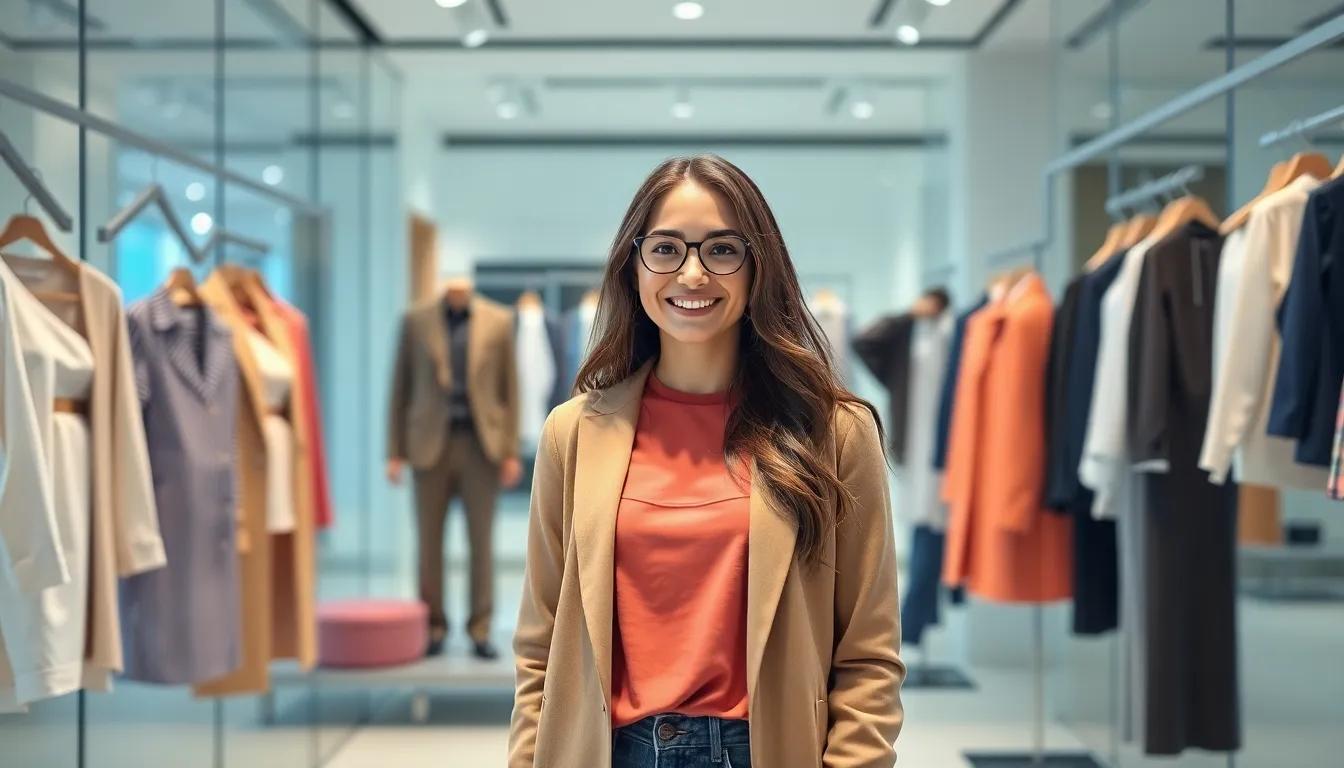Augmented reality is transforming the fashion industry in ways that were once unimaginable. By blending digital elements with the physical world, it’s creating immersive experiences that captivate consumers and redefine how they interact with brands. From virtual fitting rooms to interactive runway shows, augmented reality is not just a trend; it’s reshaping the shopping experience.
Fashion designers and retailers are embracing this technology to engage customers like never before. With AR, shoppers can visualize clothing on themselves without stepping into a fitting room, making online shopping more appealing and convenient. This innovation not only enhances customer satisfaction but also drives sales, making it a game-changer in the competitive fashion landscape. As augmented reality continues to evolve, it promises to unlock even more creative possibilities for brands and consumers alike.
Table of Contents
ToggleOverview of Augmented Reality in Fashion
Augmented reality (AR) transforms the fashion industry by creating engaging and immersive consumer experiences. AR allows customers to interact with products in unique ways, enhancing their shopping journey. Virtual fitting rooms enable shoppers to visualize how garments fit them without physical try-ons, significantly improving convenience and reducing return rates.
Fashion retailers utilize AR to showcase collections through interactive runway shows, allowing audiences to engage with designers and products in real-time. High-profile brands, like Gucci and Adidas, integrate AR into their marketing strategies, showcasing products via mobile applications and social media. This approach fosters stronger connections with consumers, encouraging brand loyalty and enhancing overall satisfaction.
AR technology also offers personalized shopping experiences. By analyzing consumer preferences, it tailors recommendations, helping shoppers discover items aligned with their tastes. In addition, AR can create social media filters that let users experiment with styles before purchase, driving engagement and online visibility.
The advantages of AR extend beyond customer interaction. Designers benefit from AR’s ability to visualize concepts and test designs virtually, significantly accelerating the design process. The integration of AR is not merely a trend; it establishes a foundation for innovation in fashion, with potential growth as technology continues to advance. Brands adopting AR technologies position themselves at the forefront of high customer engagement and enhanced shopping experiences, shaping the future of fashion retail.
Benefits of Augmented Reality in Fashion

Augmented reality (AR) provides several advantages in the fashion industry, significantly enhancing how consumers shop and interact with brands.
Enhanced Shopping Experience
AR elevates the shopping experience by allowing customers to virtually try on clothing and accessories. Virtual fitting rooms simulate a real-world fitting experience, letting users see how garments fit and look before purchasing. Brands like Warby Parker offer virtual try-ons for eyewear, while ASOS enables users to visualize outfits on their bodies through AR integration. This technology reduces the uncertainty often associated with online shopping, minimizing return rates and ensuring greater customer satisfaction.
Improved Consumer Engagement
AR fosters improved consumer engagement by creating interactive and memorable experiences. High-impact marketing campaigns, like interactive runway shows and engaging social media filters, draw consumers’ attention. When brands integrate AR into their advertising, they capture interest and promote deeper connections with their audiences. For example, Sephora’s Virtual Artist app lets users experiment with makeup virtually, enhancing their engagement with the brand and encouraging purchases. This stronger engagement leads to increased brand loyalty and repeat customers, reshaping the fashion marketplace.
Key Technologies Driving Augmented Reality in Fashion
Key technologies drive the integration of augmented reality (AR) in the fashion industry. Mobile applications and smart mirrors are two pivotal components enhancing consumer experiences.
Mobile Apps
Mobile apps facilitate immersive AR experiences, allowing users to visualize products in real time. Brands like Gucci and Adidas utilize these applications for interactive marketing campaigns, enabling customers to “try on” clothing and accessories digitally. Shoppers access a personalized experience by tracking preferences and suggesting styles based on previous interactions. Apps also leverage AR features, such as virtual fitting rooms, which significantly improve user engagement and reduce return rates. The ease of access through smartphones increases the likelihood of purchase, making AR apps essential tools for modern retailers.
Smart Mirrors
Smart mirrors represent an innovative use of AR technology in physical retail spaces. These mirrors enable customers to virtually try on clothes and accessories without physically changing outfits. High-end retailers incorporate smart mirrors into fitting rooms, providing instant feedback and alternatives based on customer preferences. Smart mirrors not only enhance the shopping experience but also streamline the decision-making process, ultimately minimizing returns. They serve as interactive platforms, showcasing product information and personalized recommendations, fostering a more engaging and efficient shopping experience.
Case Studies of Brands Using Augmented Reality
Fashion brands increasingly adopt augmented reality (AR) to enhance their consumer engagement, revolutionizing the shopping experience. The following sections highlight major fashion retailers and emerging designers leveraging AR technology.
Major Fashion Retailers
Gucci utilizes AR through its app, allowing customers to visualize shoes on their feet via real-time technology. Users can point their smartphones at their feet to see how different styles fit and look, improving confidence in purchasing decisions.
Adidas incorporates AR in its retail strategy by offering the “Creators Club” loyalty program. Through the app, members access exclusive AR experiences, including virtual try-ons and interactive promotions. This strategy not only fosters brand loyalty but also enriches customer interaction with the brand.
Sephora’s Virtual Artist app facilitates augmented reality makeup trials. Customers can try various products virtually, ensuring the makeup complements their skin tone before making a purchase. This interactive experience drives engagement while reducing return rates.
Warby Parker’s virtual try-on feature allows customers to see how glasses fit their faces using AR technology. Users can take selfies or use their device’s camera to try on different frames, streamlining the eyewear shopping process and minimizing the uncertainty often associated with online purchases.
Emerging Designers
Emerging designers increasingly embrace AR to differentiate themselves in a competitive market. For example, the brand Balenciaga introduces an AR feature in its recent collections, allowing users to interact with animated fashion items through a mobile app. This innovative approach engages consumers and enhances brand storytelling.
Another notable example, Aider, a startup, employs AR for virtual fashion shows. They create immersive experiences by showcasing collections in 3D environments. Consumers can explore the designed pieces interactively, connecting them to the narrative behind the clothing.
The designer Anouk Yve integrates AR into her marketing strategy by allowing customers to customize clothing in real-time using AR technology. This personalization enhances the customer journey, establishing a deeper connection between the consumer and the designer.
Overall, both major retailers and emerging designers demonstrate that AR technology significantly transforms how consumers engage with fashion brands, offering unique experiences that drive brand loyalty and satisfaction.
Challenges and Limitations
Augmented reality in fashion faces several challenges and limitations that can impede its widespread adoption. These factors include technological hurdles, cost implications, and user adoption rates.
- Technological Hurdles: Developing AR experiences requires sophisticated technology and infrastructure. High-resolution graphics, quick processing speeds, and robust software solutions are essential for seamless interactions. Inconsistent internet connectivity can disrupt the user experience, leading to dissatisfaction.
- Cost Implications: Implementing AR technology demands substantial investment. Developing custom AR applications, integrating existing systems, and maintaining technology incur significant costs. Smaller brands may find it difficult to allocate budgets for such innovations, hindering their ability to compete with larger entities.
- User Adoption Rates: Despite growing interest in AR, some consumers hesitate to embrace new technology. A lack of familiarity with AR features can create a learning curve. Users may prefer traditional shopping methods, making it challenging for brands to convert them to AR-driven experiences.
- Data Privacy Concerns: AR applications often require personal data to deliver personalized experiences. Consumers may be reluctant to share their preferences and information, stemming from privacy concerns. Brands must ensure transparency in data usage to build trust.
- Limited AR Content: The availability of quality AR content is still limited. Many brands struggle to create engaging and diverse AR experiences. Without a robust library of AR applications, customers may find the technology less appealing.
- Technical Limitations of Devices: AR experiences may be restricted by users’ smartphones or devices. Not all consumers own devices capable of supporting high-end AR applications, limiting access and engagement.
- Fitting Room Realism: Virtual try-ons may not accurately represent how clothing fits in real life. Discrepancies between digital representations and physical products can lead to consumer dissatisfaction and increased return rates.
Augmented reality holds immense potential in the fashion industry, but addressing these challenges is essential for maximizing its impact. Brands must focus on developing solutions that enhance user experience and foster greater acceptance among consumers.
Future Trends in Augmented Reality in Fashion
Augmented reality (AR) in fashion is poised for significant evolution as technology advances. AR’s integration is expected to expand beyond basic applications, introducing more sophisticated experiences for consumers.
- Enhanced Virtual Try-Ons: Brands will implement advanced AR solutions that provide even more realistic try-on experiences. Improvements in facial recognition and body measurement technology will allow consumers to visualize how clothing styles look on them with greater accuracy.
- Interactive Shopping Environments: Retail stores will adopt immersive AR shopping environments where customers can engage with products through digital experiences. This transformation relies on AR features that enhance product displays, making shopping more engaging.
- Sustainable Fashion Solutions: AR technology will support sustainable practices by allowing consumers to explore sustainable options. Through virtual interactions, brands will showcase eco-friendly materials and production processes, promoting transparency.
- Personalized Marketing Experiences: As AR applications advance, brands will utilize consumer data to offer tailored experiences. Customization options will allow users to design outfits or accessories, fostering a personalized shopping journey.
- AI-Driven AR Integration: Artificial intelligence will play a vital role in AR development. AI algorithms will personalize user interactions, enhancing the relevance of AR experiences based on shoppers’ past behaviors and preferences.
- Collaborations and Partnerships: Fashion brands will pursue partnerships with tech companies to push the boundaries of AR. Collaborative efforts will focus on creating innovative applications that engage consumers and enhance brand storytelling.
- Social Media Integration: Future trends indicate a seamless merger of AR with social media platforms. Brands will enhance user-generated content, allowing customers to share their virtual try-ons and experiences, thereby driving engagement.
- Increased Accessibility: Efforts will increase to provide AR experiences on various devices. Brands will optimize applications to ensure users can access AR features without high-end devices, broadening consumer reach.
These trends indicate that AR will continue transforming the fashion landscape. Brands that embrace these innovations will likely gain a competitive advantage, appealing to both tech-savvy and traditional shoppers.
Augmented reality is revolutionizing the fashion industry by enhancing consumer experiences and fostering deeper brand connections. As AR technology continues to evolve, it offers exciting opportunities for both established brands and emerging designers to create interactive and personalized shopping journeys. The integration of AR not only boosts customer engagement but also streamlines the decision-making process, making online and in-store shopping more enjoyable.
While challenges remain, the potential for AR in fashion is undeniable. Brands that embrace this technology will likely lead the way in shaping the future of retail, offering innovative solutions that cater to consumer preferences. As AR becomes more accessible and user-friendly, it’s set to redefine the fashion landscape, ensuring that brands stay competitive in an ever-changing market.


